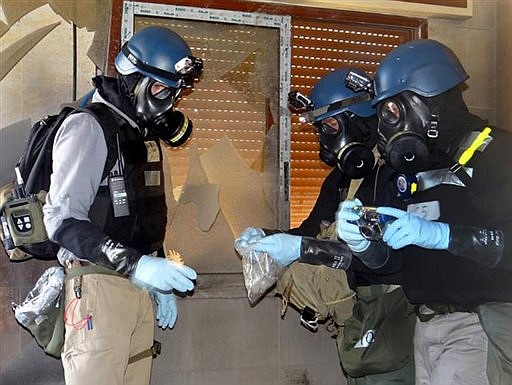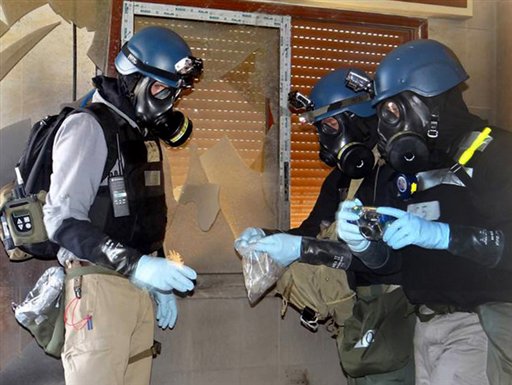UNITED NATIONS - The United States is concerned that the Islamic State group and other terrorists could get a hold of chemical weapons if Syria is hiding any stockpiles, the U.S. ambassador to the United Nations said Thursday.
Samantha Power spoke to reporters after the Security Council received a briefing from Sigrid Kaag, who heads the international effort to rid Syria of its chemical weapons.
The joint mission of the United Nations and the Organization for the prohibition of Chemical Weapons will end at the end of the month after destroying nearly all of Syria's declared stockpile. But Kaag said the OPCW is still working with Syria to resolve discrepancies in its declaration, which she said range from outdated records to discrepancies on the volume of materials.
Power said the U.S. is concerned not only that President Bashar Assad's regime still has chemical weapons but that any stockpiles left behind could end up in the hands of the Islamic State group, which has seized large swaths of Syria and Iraq.
"Certainly if there are chemical weapons left in Syria, there will be a risk that those weapons fall into ISIL's hands. And we can only imagine what a group like that would do if in possession of such a weapon," Power said, referring to the militant group by one of its known acronyms.
She said the "Security Council intends to stay very much on top of this."
Power stressed, however, that the immediate concern is that Assad's regime still possesses chemical weapons, saying that "there is one actor that has actually used chemical weapons."
There was no immediate reaction from Syria's U.N. Mission to Kaag's briefing or Power's remarks.
Syria agreed to give up its chemical arsenal last year when President Barack Obama threatened missile strikes in retaliation for a chemical attack on a rebel-held suburb of Damascus, believed to have killed more than 1,000 people. Assad's government had denied involvement in the attack, blaming the rebels.
The weapons, tons of them, were destroyed aboard the U.S. cargo vessel MV Cape Ray in international waters.
Kaag said 96 percent of Syria's declared chemical weapons and related material has been destroyed, including 100 percent of the country's "priority weapons." Kaag said it will take five to six months to destroy 12 remaining production facilities.
Questions persist over whether Assad is hiding undeclared poison gases and there is an investigation into reports of alleged chlorine gas use in some Syrian towns. Chorine is not specifically classified as a chemical weapon.
The OPCW will oversee the pending tasks after the joint mission ends, including revisions to Syria's chemical weapons declaration.
Kaag said work on amending the declaration has been a "very constructive and very cooperative" process between the Syrian government and the international authorities. OPCW Director General Ahmet Uzumcu has previously acknowledged that Syria could be hiding some of its arsenal, but he has said Syria's declared stockpile was close to estimates made by outside experts.
Power said the U.S. and other Security Council members remain suspicious and still want monthly updates on the elimination effort.
"The international community must continue to press for the resolution of all discrepancies and omissions in Syria's original declaration," she said. "We must ensure that the Syrian government destroys its remaining facilities for producing chemical weapons within the mandated time frames and without the repeated delays by the Assad regime that plagued earlier removal efforts."

